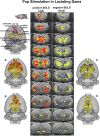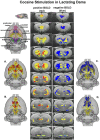Pup suckling is more rewarding than cocaine: evidence from functional magnetic resonance imaging and three-dimensional computational analysis
- PMID: 15634776
- PMCID: PMC6725197
- DOI: 10.1523/JNEUROSCI.3156-04.2005
Pup suckling is more rewarding than cocaine: evidence from functional magnetic resonance imaging and three-dimensional computational analysis
Abstract
Nursing has reciprocal benefits for both mother and infant, helping to promote maternal behavior and bonding. To test the "rewarding" nature of nursing, functional magnetic resonance imaging was used to map brain activity in lactating dams exposed to their suckling pups versus cocaine. Suckling stimulation in lactating dams and cocaine exposure in virgin females activated the dopamine reward system. In contrast, lactating dams exposed to cocaine instead of pups showed a suppression of brain activity in the reward system. These data support the notion that pup stimulation is more reinforcing than cocaine, underscoring the importance of pup seeking over other rewarding stimuli during lactation.
Figures





References
-
- Fleming AS, Korsmit M, Deller M (1994) Rat pups are potent reinforcers to the maternal animal: effects of experience, parity, hormones and dopamine function. Psychobiology (Austin, Tex) 22: 44-53.
-
- Genovese CR, Lazar NA, Nichols T (2002) Thresholding of statistical maps in functional neuroimaging using the false discovery rate. NeuroImage 15: 870-878. - PubMed
Publication types
MeSH terms
Substances
Grants and funding
LinkOut - more resources
Full Text Sources
